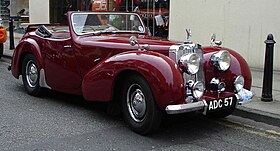Triumph 2000 Roadster
| Triumph Roadster | |
|---|---|

Triumph 1800 Roadster
|
|
| Overview | |
| Manufacturer | Standard Motor Company |
| Production |
|
| Body and chassis | |
| Class | Sports car |
| Powertrain | |
| Engine |
|
| Transmission |
|
| Dimensions | |
| Wheelbase | 100 in (2,540 mm) |
| Length | 168.4 in (4,277 mm) |
| Width | 64 in (1,626 mm) |
| Curb weight |
|
| Chronology | |
| Successor | Triumph TR2 |
The Triumph Roadster is an automobile which was produced by Britain's Standard Motor Company from 1946 to 1949. It was first available as the Triumph 1800 Roadster (18TR) from 1946 to 1948 and then as the Triumph 2000 Roadster (TRA) from 1948 to 1949.
The 1800 Roadster, model number 18TR, was designed in the closing days of World War II. Triumph had been bought by the Standard Motor Company in 1944, and the managing director of Standard, Sir John Black, wanted a sports car to take on Jaguar, who had used Standard engines in the pre-war period. Frank Callaby was selected to style the new car. After getting Black's approval for the general shape, Callaby worked with Arthur Ballard to design the details of the body. Design of the rolling chassis was by Ray Turner. Walter Belgrove, who had styled the pre-war Triumphs and was employed as Chief Body Engineer, had no part in the design.
Early post-war steel shortages meant that the body was built from aluminium, using rubber press tools that had been used making panels for the largely wooden bodied Mosquito bomber that had been built by Standard during the war. The frame was hand welded up from steel tube. The engine was a version of Standard's 1.5-litre, four-cylinder side-valve design that had been converted to overhead valves by Harry Weslake and built by Standard exclusively for SS-Jaguar before World War II. The Triumph version differed from the Jaguar version in having a 6.7:1 compression ratio instead of the Jaguar's 7.6:1 and a downdraught Solex carburettor instead of the Jaguar's side-draught SU. A four-speed gearbox with synchromesh on the top three ratios was used.
...
Wikipedia
